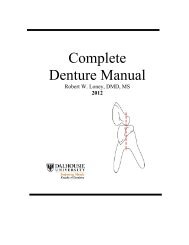RPD Manual 11 - Removable Prosthodontics - Dalhousie University
RPD Manual 11 - Removable Prosthodontics - Dalhousie University
RPD Manual 11 - Removable Prosthodontics - Dalhousie University
You also want an ePaper? Increase the reach of your titles
YUMPU automatically turns print PDFs into web optimized ePapers that Google loves.
Direct and Indirect Retainers - 53<br />
The I-bar and the proximal plate disengage the abutment tooth and thereby reduce torquing of<br />
the tooth. This is an accurate deduction. Therefore the RPI design be used wherever possible.<br />
However, an I-bar cannot be used routinely due to the fact that a tissue undercut frequently exists<br />
in the region of the abutment.<br />
A distal rest concept has drawbacks if designed incorrectly. If the guiding plane on the distal<br />
surface of the abutment covers the entire length of the tooth, loading of the denture base will<br />
cause the minor connector contacting the guiding plane to act as a "wrench" and torque the tooth.<br />
However, if a short guiding plane is prepared with a relief area between the converging surface<br />
of the tooth and the minor connector, the distal tilting of the abutment can be prevented or<br />
minimized. During distal loading, the minor connector could move into the relief area and the<br />
rest would be permitted to escape from the rest seat. This would change the fulcrum point from<br />
point A to point B, driving the abutment tooth mesially against adjacent tooth.<br />
However, if the retentive arm is place into a mesiobuccal undercut, torquing might still occur,<br />
since the retentive tip would tend to rotate in an occlusal direction, thereby engaging the tooth.<br />
To minimize the activating effect of the retentive arm, a wrought wire arm should be used<br />
(greater flexibility, less ability to torque). In addition and where possible, the retentive undercut<br />
should be place in the mid-buccal of the tooth, with the mesial clasp tip placed above the height<br />
of contour. Thus occlusal movement of the clasp tip will disengage rather than engage the tooth.<br />
Similarly, lingual bracing arms should not be carried too far into embrasures in distal extension<br />
cases, since tissueward movement could also result in torquing forces being placed on the<br />
abutments.















